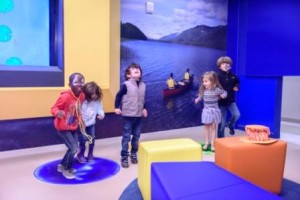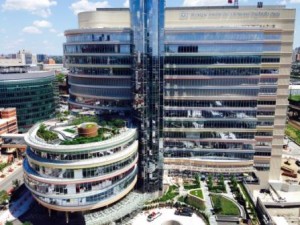The Children’s Hospital of Philadelphia expanded to create a new ambulatory care building, called the Buerger Center for Advanced Pediatric Care, in order to ensure we were addressing the medical needs of a changing patient population. CHOP actively involved the patient and family voice from inception to completion in the design, planning, patient flow layout and construction of the Buerger Center. Due to growing number of children diagnosed and treated for Autism Spectrum Disorder and their unique needs, it was vital that the design process include families who have a child with ASD.
PROBLEM IDENTIFICATION & SOLUTION
In 2015, there were 17,821 visits by children with an Autism Spectrum Disorder (ASD) to CHOP locations. According to Baio (2014) ASD is currently being diagnosed in 1 and 68 American children. Due to the growing number of children diagnosed and treated for Autism Spectrum Disorder and their unique needs, it was vital that the design process includes families who have a child with ASD and other developmental disabilities. The Children’s Hospital of Philadelphia consulted with Autism Family Partners to  gather feedback on the Buerger Center with hopes of creating a more inclusive environment that addresses the unique needs of this pediatric patient population. Family Partners (including Autism Family Partners) and the Youth Advisory Council engaged with architects and worked side by side with leadership to address specific patient needs: (1) Reduced wait times and (2) low sensory waiting area. After the building was constructed and inhabited, the Family Consultant team collected quantitative and Qualitative data to evaluate whether patient needs were met. Survey data was used to assess the utility of registration kiosks in reducing wait times for the Otolaryngology, Audiology & Speech and Language departments’ on the 5th floor of the Buerger Center. This floor was chosen due to the higher volume of patients with ASD with appointments in these departments.
gather feedback on the Buerger Center with hopes of creating a more inclusive environment that addresses the unique needs of this pediatric patient population. Family Partners (including Autism Family Partners) and the Youth Advisory Council engaged with architects and worked side by side with leadership to address specific patient needs: (1) Reduced wait times and (2) low sensory waiting area. After the building was constructed and inhabited, the Family Consultant team collected quantitative and Qualitative data to evaluate whether patient needs were met. Survey data was used to assess the utility of registration kiosks in reducing wait times for the Otolaryngology, Audiology & Speech and Language departments’ on the 5th floor of the Buerger Center. This floor was chosen due to the higher volume of patients with ASD with appointments in these departments.
Qualitative data was collected by touring the low sensory waiting area with Autism Family Partners who were asked to respond to questions relating to whether or not the low sensory waiting includes area would work for their child as well as what they might suggest as improvements. The collaboration of Family Partners, Youth Advisory Council and ASD Family Partners helped the hospital design a building with an innovative wait area that is inclusive of all pediatric populations and meet the needs of ASD patients.
PATIENT & FAMILY INVOLVEMENT
CHOP’s Family Advisory Council and Youth Advisory Council served as a main point of contact in the early planning/designing of the Buerger Center for Advanced Pediatric Care. Both advisory councils as well as Family Partners and Autism Family Partners remained fully involved and were consulted at every phase of the project. A unique and strong partnership between CHOP’s senior leadership and Family Consultants insured that the family voice consistently remained at the table from the ground breaking to ribbon cutting. Family Consultants are parents of children who have been treated at the hospital who are hired as paid staffers to champion and advance Family-Centered Care. The Family Consultants worked side by side over several years with the project’s construction and design team collaborating on everything from the location of elevators and signs to the layout of treatment rooms and waiting areas to create a truly Family-Centered facility. The Family Consultants and the Senior Director of Ambulatory Services lead the team in overcoming obstacles and resistance to bringing the family voice to the table alongside voices of architects, engineers, senior clinicians, hospital administrators and members of board of trustees in order to meet the needs of a changing pediatric patient population.
COMMUNICATION INITIATIVES
The team consistently communicated to the hospital’s executive team about the progress of the partnership, innovations or additions to the project by presenting to the Family Advisory Council and assuring a family consultant was a participant in the design meetings . Examples of innovations that lead to creating a more inclusive space are: rerouting patient flow for easier, simpler access, creating unique technology enabling clinicians to enter information into the EMR without having to turn their back to patients & families, innovative play & learn areas designed to engage and involve patients and families during all phases of their visits.
INSPIRING STAFF TO FOCUS ON PATIENTS & FAMILIES
The Family Consultants worked side by side over several years with the project’s construction and design team. The Family Consultants and the Senior Director of Ambulatory Services lead the team in methods to overcome obstacles and resistance to the family voice. In attempts to facilitate a mutual relationship, Family Consultants provided communication sessions with staff at the Buerger Center to help them better engage with patients and families. The team provided staff with actionable tools to help them build trust and partner with families in a way that was caring and compassionate.
TRANSFORMATION OF CARE DELIVERY
After the Buerger Center was designed and built with the family voice Amy conducted an Evaluative assessment of Buerger with the help of Family Partners. Amy’s project focused on assessing the inclusiveness of the ENT, Audiology and Speech and Language Departments within the Buerger Center due to the higher volume of patients with ASD visiting those departments, and whether the needs of children with ASD as well as other developmental special needs relating to wait times and inclusiveness were met. Overall, families have found that their input/feedback into planning and construction helped to decrease wait times with the addition of registration Kiosks and made for a nice low sensory waiting area. During the evaluation, Family Partners made suggestions for further improvements to enhance the hospital experience for children with ASD in a low sensory environment. As a result, two additional suggestions provided by Autism Family Partners are being explored for further improvements (adding an encased TV and Techno Flooring Liquid Motion Tiles).
IMPACT ON PATIENT EXPERIENCE & OUTCOMES
Quantitative and qualitative feedback were collected to determine the utility of kiosks effects on wait times and if the wait area is inclusive for ASD patients. The results show that through adding kiosks, registration duration has decreased from an average of 12.2 minutes to 2.3 minutes with a 98% patient satisfaction rate. 85% of families surveyed said that their overall kiosk check-in experience was positive. 100% said that the screens on the kiosk were user friendly and easy to complete. 100% of kiosk users reported that they’d use the kiosk to check in again.
Qualitative data was collected by touring the ENT, Audiology & Speech, Language Departments and low sensory waiting area with Autism Family Partners. Feedback shared highlighted that families liked the low noise levels, circular windows where kids can visualize activities in the gym on the floor below, good height on the curtains which aren’t accessible to children. Families also shared feedback on what did not work well for their child and made suggestions on areas of improvement, such as better signage, adding a TV, and recommended that some areas should still involve activities, colors, lights and low sound.





